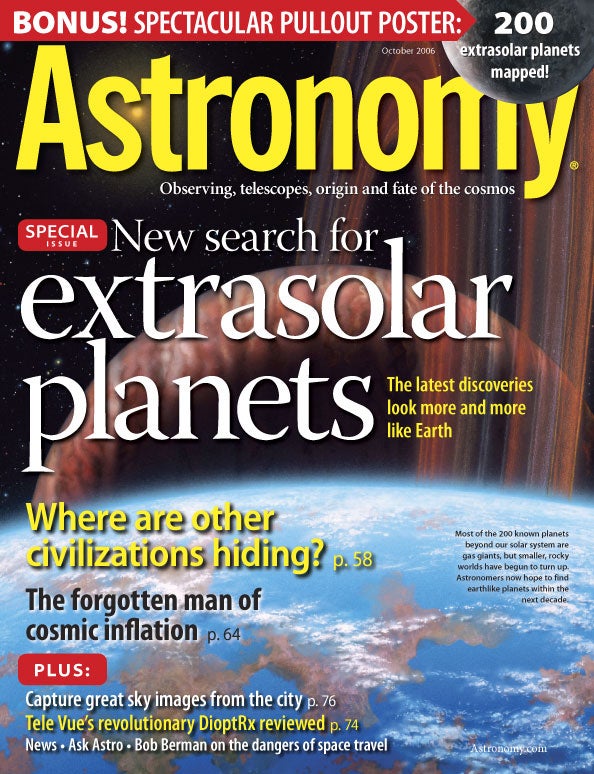
Astronomy promotes the science and hobby of astronomy through high-quality publications that engage, inform, entertain, and inspire.
More Astronomy resources:
Astronomy news
This week’s sky events
Astronomy basics
Glossary of astronomical terms
Return to Astronomy “For the media” page
Matt Quandt
Public Relations Specialist
[t] 262.798.6484
[e] mquandt@kalmbach.com
August 22, 2006
WAUKESHA, WI – As astronomers and the public recover from the news that Pluto is no longer considered a planet, Astronomy magazine’s October issue takes a look at the search for planets outside our solar system – also known as extrasolar planets. The quest for extrasolar planets is one of the hottest areas of astronomical research. As of today, astronomers know of 204 exoplanets, most of which orbit Sun-like stars. In addition to learning more about what these objects can tell us about how many planets our galaxy holds, discovering planets like Earth is an important step in the search for life in the universe.
The October 2006 Astronomy offers readers a special, in-depth report on the quest for exoplanets. A pullout poster, “Atlas of extrasolar planets,” highlights this special section. This poster features a three-page map of all the known exoplanets, plus illustrates the techniques used to find them.
We’re huntin’ planets
Geoffrey Marcy‘s “The new search for distant planets” explains how astronomers are closer to discovering worlds that might resemble our own. With more exoplanet discoveries under his belt than anyone else, Marcy provides Astronomy readers an unparalleled look at his team‘s methods, successes, and ambitions.
Where do these big guys come from?
Alan Boss‘ “How do you make a giant exoplanet” lays out the theories of how giant exoplanets – imagine Jupiters and Saturns – form. Astronomers want to know how these giant planets are created. Boss, a researcher at the Carnegie Institution of Washington, explains the successes and failures of theories about how big planets form.
Rogue planets
Astronomers now also find giant planets floating freely in the Milky Way, unattached to any star. Even more interesting: These isolated giant planets may be the Milky Way’s most common worlds. In “Planets without suns,” Maria Rosa Zapatero Osorio – an astronomer at the Institute for Astrophysics in La Laguna, Tenerife, in Spain’s Canary Islands – states “We have only just begun to understand the properties, genesis, and evolution of these surprising objects.”
Life beyond our solar system
Margaret Turnbull, also at the Carnegie Institution of Washington, wraps up Astronomy‘s special report on extrasolar planets with her investigation into “Where is life hiding?” The search for habitable planets naturally follows the search for extrasolar planets. Once astronomers locate an exoplanet, they try to determine if it is habitable. The golden rule in real estate proves true for habitable worlds: location, location, location.
The guy behind the guy
Steve Nadis’ “The most important cosmologist you’ve never heard of,” profiles Cornell University physics professor Henry Tye. As inflation’s unsung hero, Tye continues to transform cosmology 30 years after helping Alan Guth come up with the landmark “cosmic inflation” theory. While Guth set about crafting his inflationary universe theory, Tye was on a 6-week trip to China to visit his grandmother and attend a conference. Lately, Tye’s busy developing new strategies for probing the universe’s origin. A quiet force in the study of the origin and fate of our universe, Henry Tye patiently and deliberately lays the groundwork for the next breakthrough in cosmology.
Also in the issue
“The sharpest image” – Put away your eyeglasses, Tele Vue‘s DioptRx lenses correct astigmatism.
“Shooting through the light” – Learn how one astroimager succeeds in a light-polluted sky.
“Head of the glass” – Ease of use and terrific optics place the Stellarvue SV4 high on any observer’s want list.
The October 2006 Astronomy also includes Ask Astro, Astro news, Bob Berman’s strange universe, Glenn Chaple’s observing basics, Phil Harrington’s binocular universe, The sky this month, New products, and Reader gallery.
Copies available
To request a copy of the October 2006 Astronomy or to set up an interview, please contact Matt Quandt: 262.798.6484 or mquandt@kalmbach.com.









